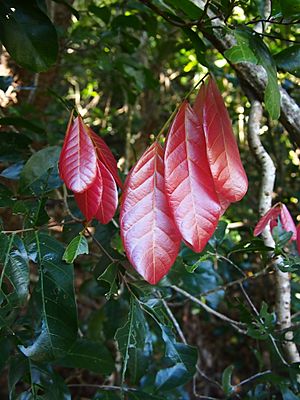Rose tamarind facts for kids
Quick facts for kids Rose tamarind |
|
|---|---|
 |
|
| Arytera divaricata at the Royal Botanic Gardens, Sydney | |
| Scientific classification | |
| Genus: |
Arytera
|
| Species: |
divaricata
|
| Synonyms | |
The Arytera divaricata, also known as the gap axe, coogara, coogera, or rose tamarind, is a beautiful forest tree. It grows in the eastern parts of Australia. This plant is very attractive, especially its new leaves, which are shiny, pale, and a bit floppy. You can often find it in drier areas, like coastal rainforests or monsoon forests.
This tree naturally grows from Port Stephens in New South Wales all the way north to Cape York. Cape York is the northernmost tip of Australia. The name Arytera comes from a Greek word meaning "cup." This is because the fruit parts look like small cups. The word divaricata comes from Latin and describes how the flower branches spread out widely.
Contents
What Does the Rose Tamarind Look Like?
The rose tamarind can be a small or large tree. Its older leaves are dark green. It can grow taller than 35 meters (about 115 feet). However, you usually see it as a smaller tree, often less than ten meters (about 33 feet) tall. The bottom of the tree trunk often has a slightly wider, flanged shape. Its bark is smooth, thin, and greyish.
Leaves, Flowers, and Fruit
The leaves grow in pairs along a central stem, with two to six pairs of smaller leaflets. Each leaflet is shaped like a spear or an egg. They are not toothed along the edges. These leaflets are usually 5 to 15 centimeters (2 to 6 inches) long and 1.5 to 6 centimeters (0.6 to 2.4 inches) wide. They feel a bit hairy and leathery. The leaves are usually not very pointy at the end. They are shiny green on top. When new, the leaves can be red, then pink, and finally yellow. The small stem holding each leaflet is 3 to 6 millimeters (0.1 to 0.2 inches) long. The main vein in the middle of the leaf sticks out on both sides. You can clearly see 8 to 12 main side veins on the leaves.
The flowers appear between November and April. They are creamy white in color. They grow in wide, hairy clusters called panicles. After flowering, the tree produces a fruit. This fruit is a capsule with three distinct sections. Inside, you'll find brown, oval-shaped seeds. These seeds are covered in a red, fleshy layer called an aril. The seeds are ready from June to October. They usually sprout easily, sometimes showing roots in as little as seven days.
Why Is the Rose Tamarind Important?
The rose tamarind is considered a very beautiful and decorative tree. People often plant it for its ornamental value.
See also
 In Spanish: Tamarindo rosa para niños
In Spanish: Tamarindo rosa para niños

